A week of 90s in Seattle … my hostess and I are both heading down delirium’s loopy driveway. The notes on the piano that I don’t feel like practicing swim in the heat. I flee to an air conditioned coffeeshop.
Outside, nothing but blue sky and hipsters in shorts. The trembling tattooed hand of the barista shapes the milk into beautiful rosettes, which swirl down the drain of my throat. Gimme another, I say, like the weathered movie cowboy at the saloon, I’m thirsty, pounding my demitasse on the faux tile of the espresso bar, and instead of a gun/holster I slide my MacBook into my messenger bag and harrumph off into the blazing sunlight.
Overheated, over-caffeinated, I manufacture outrage. I scream inwardly — thoughtless accents are the enemy of music!! I want to spend my day making up similarly unnecessary manifestos, penning declarative sentences like fortifications that will piss people off. People will come to find me in my castle of This Is True, they’ll knock timorously on my leaden door of Certitude, but in the meanwhile I will have snuck off to a grass hut on the beach, lying half in and out of it, in swim trunks, my feet playing idly with the sand. So long, suckers!
Later that day, on the way to play a concert, I order myself a pizza but am disenchanted by my warm box of dough and cheese. I add a berry gelato to my order, and soon I am driving down I-5, spooning gelato frenetically into my mouth while cursing at traffic. This is not cooling enough; I start rubbing the pint of gelato all over my face and arms; the gelato melts, drips berry color all over me; my concert clothes luckily are in the back seat, looking on reproachfully, with furrowed, wrinkled cuffs. I arrive sticky and nauseous backstage. Excellent.
Hot, vexatious, residually sticky, I sit down at the piano to play:
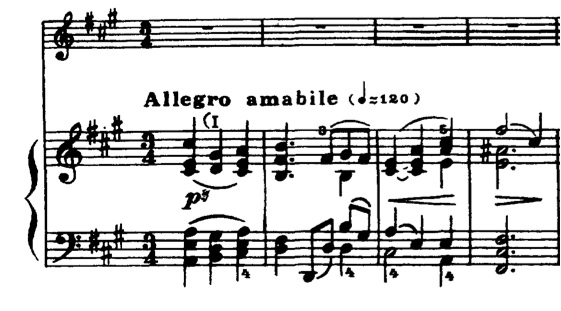
Audio clip: Adobe Flash Player (version 9 or above) is required to play this audio clip. Download the latest version here. You also need to have JavaScript enabled in your browser.
And already I am happier. I’m amiably asymmetric, ‘cause Brahms wrote my part that way! I play four inviting bars: classical, simple. But when I’m done the violin adds on one little bar, a romantic suffix:
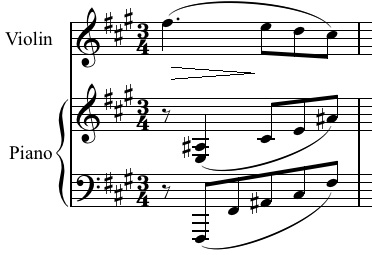
Audio clip: Adobe Flash Player (version 9 or above) is required to play this audio clip. Download the latest version here. You also need to have JavaScript enabled in your browser.
Together the four plus one make something, an interesting five. At the outset of the piece, Brahms keeps repeating this lesson, explaining this particular 4+1=5 over and over again. Almost like Sesame Street lessons in musical arithmetic? Let’s say I’m the Cookie Monster, and the violinist’s interjection is a cookie added to my hoard. I try to play each phrase with the understanding that I crave the next cookie, and–eventually, who knows?–all the cookies in the world.
Whoa, I believe I have just created Cookie Monster Musical Analysis. Schenker, eat your heart out.
There is something about this asymmetry that is flirtatious, too (most affections are asymmetrical). All the elements of the practiced flirt are there. The violinist offers but the one bar each time: a minimum of attention, but just enough to keep the piano interested. The violinist flatteringly repeats back what the piano offered, but with a more sensual, flowing rhythm: a good mixture of stroking the pianist’s ego and suggesting an alternative. This one “extra” bar is not an insertion but a compressed, distilled meaning: not just the tentative beginnings of a dialogue, but a symbol of encounter itself, a parenthetical musical rendezvous.
After the flirting is over, Brahms gives us some Serious Development:

Audio clip: Adobe Flash Player (version 9 or above) is required to play this audio clip. Download the latest version here. You also need to have JavaScript enabled in your browser.
This is a mathematics lesson, without cookies. It’s Terribly Serious; two bars of 3 are presented, then subdivided into 3 bars of 2, as if to actually embody the equation 3×2=2×3! Our delicate flirtation has become loud and square, all too quantifiable. You might complain: oh Johannes, off you go again, with your subdivisions upon subdivisions. We get it, but what’s the point?
Brahms creates this structure in order to dissolve it. One of his most characteristic and moving gestures is to create complications, and then to release and transform these cogitations into sensual delight. The “musical mathematics” do not last long; soon enough, the hemiolas become:

Audio clip: Adobe Flash Player (version 9 or above) is required to play this audio clip. Download the latest version here. You also need to have JavaScript enabled in your browser.
These two bar units are still divided into threes, but more subtly, with a softer hand. The principle of division remains; but the insistence fades. The boundaries waver. There’s a whiff of the waltz. The piano stops enunciating the quarters, and relinquishes them to a flow of eighths. Earlier, in HemiolaLand, Brahms connects his moments with stiff, bulky girders, but now, at the crucial emotional moment of juncture, we have this:
Audio clip: Adobe Flash Player (version 9 or above) is required to play this audio clip. Download the latest version here. You also need to have JavaScript enabled in your browser.
A masterstroke: starting in the fourth bar above, the violin sneaks upward chromatically, all alone. This is a transition made of nearly nothing, the most delicate possible thing, a slender thread of suspended time. A tenuous slide from one note to the next. And the pianist, invited by this gossamer gesture, enters with one of the most beautiful themes ever written, an almost iconic waltz, in which each bar is now divided into 2, though the meter is in 3 …
Audio clip: Adobe Flash Player (version 9 or above) is required to play this audio clip. Download the latest version here. You also need to have JavaScript enabled in your browser.
Within a short span, we watch Brahms convert himself from a Beethovenian Constructor to an Evanescent Waltzer.
Over this second theme, Brahms writes teneramente, tenderly: which is all you need to know? Yes, there’s a sweetness, but each “main note” of this theme is a dissonance, a discord. And each dissonance is slightly different from the last; each a different shade of wistfulness, or of pain. I came offstage with S and we smiled at each other feeling we had shared something; a wonderful moment of musical affinity. But I kept wondering, why is this piece (of all the pieces in the world) so important to me right now? Why is the tenderness of this movement and particularly that theme so important to me amid all the crap, all the travels, and festival madness? A jaded devilish voice inside of me says it’s just Brahms A major sonata, everyone’s played it already, it’s already been done, etc. etc. but another says that that theme still has yet to be played better, that some pianist has not yet pursued all the repercussions and consequences of tenderness hiding in those notes. It’s an inscrutable sweetness, a tenderness that unwinds a knot of contradiction, shows you briefly how the knot is made — and closes it up again.
Back in the car, I find a half-full pint of pinkish liquid, a tepid pizza, and a cell phone with a tender message on it. I press–what else?–redial. A familiar voice answers, flirtatiously.
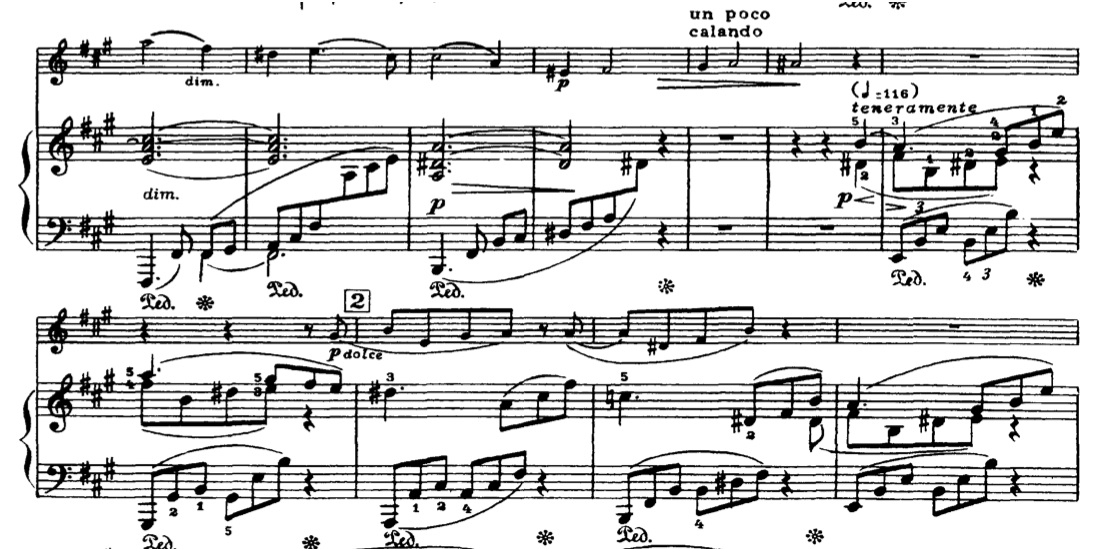
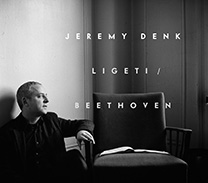
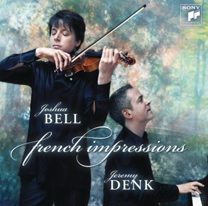
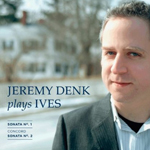
22 Comments
I love getting whisked away into your imagination; never disappointed, I return knowing I’ve learned something new. You inspire, teach and entertain. Thanks again, Jeremy!
It is so good to have you back again Jeremy – I missed you! I’d love arithmetic taught by Jeremy through music 😉 *big hug*
Huzzah you’re back! I would totally buy a one way ticket to HemiolaLand.
Shakespeare has already been done, too…yet I look forward to every new performance. Music is just notes on a page until it is performed. Brahm’s Composition + Your Performance = Art. And for that, I thank you.
I especially liked the pounding of your demitasse.
If you Google “Cookie Monster Musical Analysis,” you get exactly one hit–this blog. So congratulations, you have truly invented something new, which is hard to do these days.
I was beginning to exhibit withdrawal symptoms from your long absence. So glad to read a new one from you, Jeremy. Thanks for remembering to blog again. I learned a lot from it.
When you hit up the true soul music like Brahms violin sonatas it’s not to be missed. Who was your mysteriously-initialed artistic accomplice I wonder?
Mike–
I believe that would be the lovely if unpronounceable Stefan Jackiw.
As Aretha so wonderfully sings, “Darling, you send me”. Your Bridgehampton performance brought your audience such joy. I’m just touching down. Honest. Reading these responses, seems like we all have a wee case of “Jeremania”. Feels good.
I’ve certainly got a case of Jeremania 😉
You asked why this piece is so important to you right now in the midst of all the stuff going on. I think it has something to do with last spring’s Bach.
Please don’t ask me to explain that. I haven’t a clue what I’m talking about. But sometimes I get flashes, and sometimes they mean something.
Thought it couldn’t hurt to offer this one.
If you walk down the the unpaved part of Cruger Island Road at Bard until it dead ends in the forest, you will find that someone has abandoned a Wurlizer piano out there. It’s sorely out of tune, but one octave is still vaguely playable.
Who was the violinist?
Hello Jeremy! Loved this arm-in-arm exploration of (another) Brahms 2nd. I wondered if that whole opening phrase were in a solo piano piece – 5th bar as well – whether we’d play the 4th bar differently? It’s so difficult to play as it is because we want to finish off the beautiful phrase in bar 4 rather than letting the violin make the really significant contribution in the following bar.
Jeremy! This is so entertaining.
Sorry about the heat, most unusual. I think 3/4 and other uneven rhythms exist to try to capture a kind of lyricism and defeat our expectations of starting, stoppig and repeating [listen to the Pro Cantionae Antiqua disc of Gaude Virgo of Dunstable, or Rose, Lis by Machaut]. You come very close to unlocking the meaning in music when you analyse, as you do, HOW the music speaks [not what it says. Listen to Kiri’s first disc of Strauss’ 4 Last Songs, universally panned as light-weight, but makes the music speak perfectly.
Jeremy, you are not only a great pianist, but an imaginative and creative writer.
Regarding Brahms A Major Sonata, who cares how many times its been performed by artists both great and mediocre. It’s just a wonderful piece of music, and always open to a different interpretation, a different but subtle nuance.
Your last post mentioned “a Leon,” in that case Kirschner. Reading your Brahms post, it brought to kind another Leon, in this case Fleischer. An old disc of his from the late 1950s included Brahms’ Handel Variations and the Waltzes, Op. 39. We seldom hear that set in its entirety; though it contains woderful pieces, I guess it doesn’t come off as a set because it ends on a very inconclusive waltz of relatively little merit. But the preceeding numbers are heavenly. Perhaps if performed with the addition of another final piece, without break, say one of Brahms’ Rhapsodies, it would leave a better overall impression on an audience.
In any case, please read my blog “Eclectic Renaissance Man” when you have a moment.
Best,
Bill Breakstone
Jeremy Denk,
You have…for lack of a better word… trinitized powers to unlock the door to revelation here….the notes unraveling by virtue of this greater union that is without dualistic separation. But it comes out of three….and she walks in to the most beautiful…serendipity ever known Man.
Heather Blodgett
Leon Kirchner’s Grand Daughter
Writing from Toronto, Canada. Do I need a valid passport to get across the border into HemiolaLand?! Cheers, Urban Flute
I flew in to the Bay Area from Sydney on Saturday to attend your concert in Berkeley with Joshua Bell. It was sublime. Mr. Bell perhaps receives more attention, but your playing was truly wonderful. The violin would have been not so great without you. Thank you for sharing your wonderful gift with the world.
You are a silly, silly man. 🙂